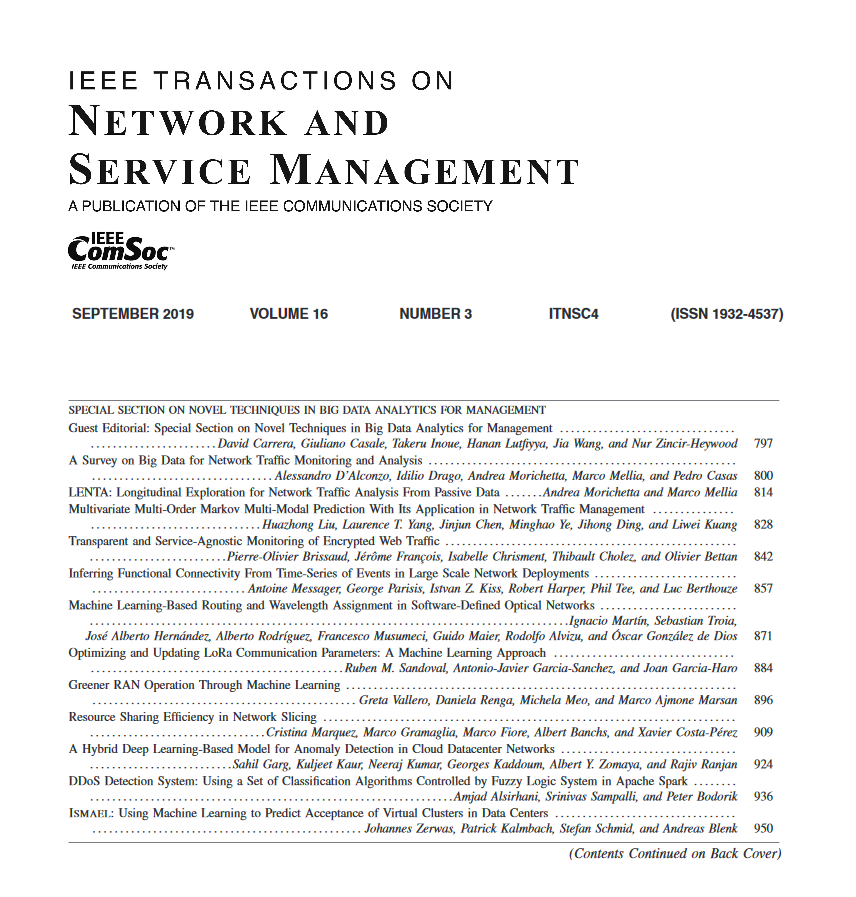使用 Venn-Abers 预测器识别微波网络中的 ASAP 硬件故障原因
IF 4.7
2区 计算机科学
Q1 COMPUTER SCIENCE, INFORMATION SYSTEMS
IEEE Transactions on Network and Service Management
Pub Date : 2024-07-17
DOI:10.1109/TNSM.2024.3430052
引用次数: 0
摘要
我们研究通过机器学习(ML)对微波网络中的硬件故障进行分类。虽然基于 ML 的方法在这项任务中表现出色,但它们通常只能提供硬故障预测,而不能保证其可靠性,即正确分类的概率。一般来说,在更长的时间跨度内积累数据可以提高模型的预测准确性。因此,在实际应用中,需要在两个截然不同的目标之间进行权衡:i) 确保每个分类观测结果的高可靠性;ii) 收集最少的数据量以提供可靠的预测。为了解决这个问题,我们将硬件故障原因识别表述为一个 "尽可能快"(ASAP)的选择性分类问题,在这个问题中,数据流被依次提供给一个 ML 分类器,一旦正确分类的概率超过用户指定的阈值,分类器就会输出预测结果。为此,我们利用归纳预测器和交叉文氏预测器将任何 ML 模型的启发式概率估计转化为严格的预测概率。在实际数据集上的数值结果表明,我们的 ASAP 框架与最先进的框架相比,预测时间缩短了约 8 倍,同时确保选择性分类准确率超过 95%。本研究中使用的数据集是公开的,旨在促进未来微波网络故障管理方面的研究。本文章由计算机程序翻译,如有差异,请以英文原文为准。
ASAP Hardware Failure-Cause Identification in Microwave Networks Using Venn-Abers Predictors
We investigate classifying hardware failures in microwave networks via Machine Learning (ML). Although ML-based approaches excel in this task, they usually provide only hard failure predictions without guarantees on their reliability, i.e., on the probability of correct classification. Generally, accumulating data for longer time horizons increases the model’s predictive accuracy. Therefore, in real-world applications, a trade-off arises between two contrasting objectives: i) ensuring high reliability for each classified observation, and ii) collecting the minimal amount of data to provide a reliable prediction. To address this problem, we formulate hardware failure-cause identification as an As-Soon-As-Possible (ASAP) selective classification problem where data streams are sequentially provided to an ML classifier, which outputs a prediction as soon as the probability of correct classification exceeds a user-specified threshold. To this end, we leverage Inductive and Cross Venn-Abers Predictors to transform heuristic probability estimates from any ML model into rigorous predictive probabilities. Numerical results on a real-world dataset show that our ASAP framework reduces the time-to-predict by ~8x compared to the state-of-the-art, while ensuring a selective classification accuracy greater than 95%. The dataset utilized in this study is publicly available, aiming to facilitate future investigations in failure management for microwave networks.
求助全文
通过发布文献求助,成功后即可免费获取论文全文。
去求助
来源期刊

IEEE Transactions on Network and Service Management
Computer Science-Computer Networks and Communications
CiteScore
9.30
自引率
15.10%
发文量
325
期刊介绍:
IEEE Transactions on Network and Service Management will publish (online only) peerreviewed archival quality papers that advance the state-of-the-art and practical applications of network and service management. Theoretical research contributions (presenting new concepts and techniques) and applied contributions (reporting on experiences and experiments with actual systems) will be encouraged. These transactions will focus on the key technical issues related to: Management Models, Architectures and Frameworks; Service Provisioning, Reliability and Quality Assurance; Management Functions; Enabling Technologies; Information and Communication Models; Policies; Applications and Case Studies; Emerging Technologies and Standards.
 求助内容:
求助内容: 应助结果提醒方式:
应助结果提醒方式:


